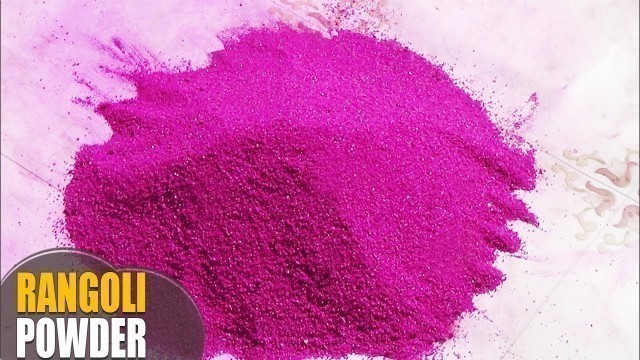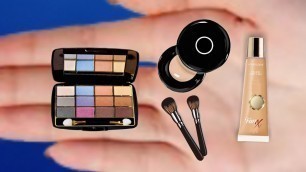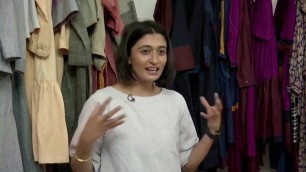

'రంగు రంగుల ముగ్గుల రంగులు ఇంట్లోనే సులభంగా తాయారు చేసుకొనుట Channel..rangoli, also known as Kolam, is a from India in which patterns are created on the floor in living rooms or courtyards using materials such as colored rice, dry flour, colored sand or flower petals. It is usually made during Diwali (Deepawali), Onam, Pongal and other Indian festivals. They are meant to be sacred welcoming areas for the Hindu deities. Designs are passed from one generation to the next, keeping both the art form and the tradition alive. Similar practices are followed in different states of India: Rangoli in Karnataka, Kolam in Tamil Nadu, Mandana in Rajasthan, Chaookpurna in Chhattisgarh, Alpana in West Bengal, Aripana in Bihar, Chowk pujan in Uttar Pradesh, Muggu in Andhra Pradesh, Golam kolam or kalam in Kerala and others except in North eastern states. It is traditionally done by women. Generally, this practice is showcased during occasions such as festivals, auspicious observances, marriage celebrations and other similar milestones and gatherings. Rangoli designs can be simple geometric shapes, deity impressions, or flower and petal shapes (appropriate for the given celebrations), but they can also be very elaborate designs crafted by numerous people. The base material is usually dry or wet powdered rice or dry flour, to which sindoor (vermilion), haldi (turmeric) and other natural colors can be added. Chemical colors are a modern variation. Other materials include colored sand, red brick powder and even flowers and petals, as in the case of flower rangolis. Rangoli art is an adornment or decoration that has different names in different states of India; for example, Rangoli in Karnataka, Chaookpurna in Chhattisgarh, Mandana in Rajasthan, Aripan in Bihar, Alpana in Bengal, Sanskar Bharti in Maharashtra, Kolam in Tamil Nadu, Muggulu in Andhra Pradhesh, Alikhthap in Kumaon, Kalam in Kerala, and Saathiya in Gujarat. Not just in names, the designs also vary as per the region. In middle India mainly in Chhattisgarh Rangoli is called Chaook and is generally drawn at the entrance of a house or any other building. Dried rice flour or other forms of white dust powder is used for drawing Chaooks. Although there are numerous traditional Chaook patterns, many more can be created depending on the creativity of the person who draws it. It is considered auspicious as it signifies showering of good luck and prosperity on the house and in the family. It is not drawn like a picture. Patterns are created based on certain systems. Generally women get up early in the morning and clean the area just outside the entrance of their houses with cow dung, sprinkle the area with water and draw the Chaook. In Maharashtra, rangolis are drawn on the doors of homes so that evil forces attempting to enter are repelled. During the festival of Onam in Kerala, flowers are laid down for each of the ten days of the celebration, the design growing larger and more complex every day. In Tamil Nadu, Andhra Pradhesh and Karnataka, the Kolam is drawn upon the ground or floor daily. The designs are geometric and symmetrical मूल्यतः shapes but the materials used are similar rangoli: rice flour or slurry is used. In Rajasthan the Mandana are painted on walls. Mmandne, various festivals, major festivals and can be categorized based on seasons. Different shapes depending on the size of it also can be shared. Kumaon\'s \"writing beat \'or in a variety of plotting symbols Thapa, artistic designs, Bellbutoan is used. Alikhthap of society apart - separated by different groups - different icons and art media is used. Rangoli drawn in front of the house as a faith and traditionRangoli is either left as an unfilled line drawing or it is filled with various coloured powders Rangoli of Global Events Rangoli at Delhi Rangoli at Chennai Sankranti Muggu (Rangoli) with flowers Rangoli with flowers at Chennai Rangoli at Nizampet, Hyderabad Rangoli before and after colouring Rangoli in Singapore Rangoli of Peocock in Tamil Nadu A rangoli painted on the occasion of Diwali, a popular Hindu festival Nature Scene in Rangoli during a Vijayadashami festival, in Maharashtra A Tux rangoli by students at GNUnify\'13, Pune Rangoli is drawn in front of the house especially in festival days Rangoli at Hyderabad A rangoli made with flowers on the occasion of Onam Rangoli being prepared by a Rangoli mould vendor in Bangalore Rangoli is also created using coloured rice, dry flour, flower petals, turmeric (haldi), Vermillion (Sindoor) and coloured sand. The patterns include the face of Hindu deities, geometric shapes peacock motifs and round floral designs. Many of these motifs are traditional and are handed down by the previous generations. This makes rangoli a representation of India’s rich heritage and the fact that it is a land of festivals and colour.'
Tags: new , winter , colours , powder , How to draw , festival , Telangana , flowers , sankranthi muggulu , rangoli , how to make rangoli , how to make rangoli powder , Happy New Year 2021 , PINK COLOUR , muggu , new rangoli , new muggulu , designs video , telugu muggulu , latest & Unique , happy sankranthi , makara sankranthi , bobbamma muggulu , bobbamma , colourful rangoli , how to fill colours , how to get ideas , lathe channel , telangana muggulu , Andhra muggulu , home made rangoli , rangoli at home , sand powder
See also:

















comments